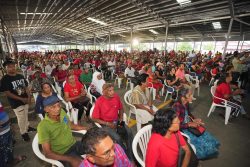Going in, although this is the traditional Sunday space in Stabroek News for my SO IT GO column, I am operating merely as a conduit this week for my wife Annette and her very focused work as an environmentalist.as she puts the spotlight on The International Day for the Conservation of the Mangrove Ecosystem, adopted by the General Conference of UNESCO in 2015 and celebrated each year on July 26th, seeking to raise awareness of the importance of mangrove ecosystems as “a unique, special and vulnerable ecosystem” and to promote solutions for their sustainable management, conservation and uses.
Ten years ago when Annette was asked by then President Jagdeo to chair the Guyana Mangrove Restoration Project, she did what she sometimes does with a project she is working on which is to solicit my volunteer services to raise awareness of the cause with some original music. In that particular case, it was to create a catchy jingle on the importance of mangroves and the mangrove jingle was born and I was delighted to find some folks in West Dem referring to me as “The Mangrove Man,” although I’m not sure the title fits.
“Sea level rising
That is true
But there is something that we can do
Protect the mangroves
The red and black mangroves
The mangroves that you see all about
Helps to keep the sea water out
Protect the mangroves
The red and black mangroves.”
Ten years later, she is still dealing with the environment but in this case working in the Barima Mora Passage in Region One, which has been confirmed to be Guyana’s largest and most intact mangrove ecosystems, on which a most beautiful short documentary was produced by her son Alex Arjoon of Reel Guyana and is available on its YouTube channel. That the documentary is anchored by Felicia Collins, a young marine scientist from Port Kaituma in Region One, is extraordinary as there are very few marine scientists generally so to have one from the region carrying her commitment to work with the Region One communities to enable them to become the stewards of their natural capital is a definite plus. It also provides a glimpse into the traditional knowledge and cultures of the Warraus who inhabit the area. One knockout moment is when the intertidal change occurs between the intrusion of salt water from the Atlantic Ocean and the fresh water of the Barima River, which depletes the affected area of oxygen and thus stunning the fish which start to float on the surface and become an easy meal for the Warraus in their canoes harvesting the bounty with custom-designed harpoons. Some of these fishermen include children as young as four and six years… and in their own canoe to boot.
Many of us are not aware of the importance of mangroves to our fisheries sector, with the roots of the mangroves serving as fisheries nurseries where the juvenile fish can take refuge from becoming an easy meal themselves to the numerous predators around them. The Barima Mora Passage documentary also features Lucienne Williams, a young Warrau who shares with us the importance of mangroves as a habitat for crabs which are an important source of protein for the Warraus as well as an income from their commercial sale at Kumaka Market. In the documentary, not only does she share her traditional knowledge of seasons of the three species such as the Blue, Red and White crabs but Lucienne also demonstrates her impressive crab-catching skills.
The Barima Mora Passage Mangroves are directly adjacent to the Shell Beach Protected Area which is Guyana’s only coastal protected area and stretches across to the border. A collaboration between the Guyana Marine Conservation Society, the University of Florida and the Jacksonville Zoo, enabled a camera trapping project in February where thirty cameras were placed throughout the forest by Felicia Collins and a team from Mabaruma to ensure that capacity which is built in the region remains there. The cameras were retrieved in May and the preliminary findings have so far revealed six International Union for Conservation of Nature (IUCN) red-listed species which is a huge deal. Amongst them there are giant anteaters, giant river otters, jaguars, pumas and white-collared peccaries. A collaboration with the Warrau community of Imbetero has resulted in the council granting one acre of land which is being cleared by the community as their inkind contribution which will accommodate a research station for both national and international students as there is commitment from both. This embryonic research tourism initiative will provide income generation opportunities for the community members who will provide supporting services such as meals, transportation and guiding to the students.
Guyana is at a pivotal stage of its development which can be balanced by meaningful Environmental, Social and Governance (ESG) programmes to support areas such as the Barima Mora Passage Mangrove Ecosystems.
As with the mangrove project, Annette is also soliciting my contribution in a song to focus attention on the project. Song-writing being a totally different creature, however, leaves me to say that while I’m agreeing to make the effort, there is no guarantee I will produce the result here that the lady is obviously expecting. I emphasise that I cannot count the number of song ideas I have assigned to the garbage bin simply because the result did not achieve the standard I was expecting. To put it more directly, “let us wait and see; it is a most worthwhile endeavour….wish me luck that I can indeed come up with a Green Gem….stay tuned!”










